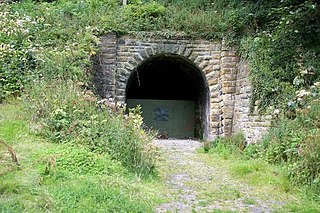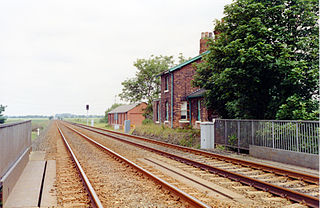
Rugby railway station serves the town of Rugby in Warwickshire, England. The current station dates from 1885; two previous stations dating from 1838 and 1840 respectively, existed at locations to the west of the current one. It has been Rugby's only station, since the closure of the former Rugby Central station in 1969, on the now-abandoned Great Central Main Line route through the town. Between 1950 and 1970, the station was known as Rugby Midland before reverting to its original title. The station underwent an extensive remodelling between 2006 and 2008; new platforms were added and a new ticket office and entrance building were constructed. The original Victorian part of the station was retained in the upgrade.
The Wakefield line is a railway line and service in the West Yorkshire Metro and South Yorkshire Passenger Transport Executive areas of northern England. The Wakefield line is coloured yellow on maps and publications by West Yorkshire Metro. The line was electrified in 1989, between Leeds & Wakefield Westgate, as part of the programme to electrify the East Coast Main Line.

The Harrogate line is a passenger rail line through parts of North Yorkshire and the West Yorkshire area of northern England connecting Leeds to York by way of Harrogate and Knaresborough. Service on the line is operated by Northern, with a few additional workings by London North Eastern Railway starting and terminating at Harrogate. West Yorkshire Metro's bus and rail MetroCard ticket is available for journeys between Leeds and Harrogate.
The North Western Railway (NWR) was an early British railway company in the north-west of England. It was commonly known as the "Little" North Western Railway, to distinguish it from the larger London and North Western Railway (LNWR).
The Preston and Wyre Railway was promoted to open up agricultural land in the Fylde in Lancashire, access a new port at what became Fleetwood and the Lancaster Canal at Preston: it opened in 1840. An associated company built the dock leading to the company changing its name to the Preston and Wyre Railway, Harbour and Dock Company. Passenger business was more buoyant than expected, and the company built branch lines to the nascent resort of Blackpool and Lytham that opened in 1846. At that time the line was leased by the Lancashire and Yorkshire Railway and later the London and North Western Railway took a share in the lease which was later converted to outright ownership. The Preston and Wyre Railway continued to be jointly owned as the Preston and Wyre Joint Railway.

Selby railway station is a Grade II listed station which serves the town of Selby in North Yorkshire, England. The original terminus station was opened in 1834 for the Leeds and Selby Railway. The Hull and Selby Railway extended the line in 1840, and a new station was built, with the old station becoming a goods shed. The station was rebuilt in 1873 and 1891, the 1891 rebuilding being required due to the replacement of the swing bridge over the Ouse at the same time.

Rotherham Masborough railway station was the main railway station for Rotherham, South Yorkshire, England from the 1840s until 1987, when most trains were rerouted via Rotherham Central. It had four platforms, with a large sandstone station building on the eastern Platform Four, large iron and glass platform canopies, a fully enclosed footbridge and wooden waiting rooms on the other platforms. It closed in 1988, except for a few football specials.

The Whitby, Redcar and Middlesbrough Union Railway (WRMU), a.k.a. the Whitby–Loftus Line, was a railway line in North Yorkshire, England, built between 1871 and 1886, running from Loftus on the Yorkshire coast to the Esk at Whitby, and connecting Middlesbrough to Whitby along the coast.

Whitby West Cliff railway station was a railway station on the Whitby Redcar and Middlesbrough Union Railway. It was opened on 3 December 1883, to serve the West Cliff area of the town of Whitby, North Yorkshire, England. It was one of two stations serving Whitby; the other was Whitby Town railway station, which served the lines to Malton and Battersby.
The Great Northern and Great Eastern Joint Railway, colloquially referred to as "the Joint Line" was a railway line connecting Doncaster and Lincoln with March and Huntingdon in the eastern counties of England. It was owned jointly by the Great Northern Railway (GNR) and the Great Eastern Railway (GER). It was formed by transferring certain route sections from the parent companies, and by the construction of a new route between Spalding and Lincoln, and a number of short spurs and connections. It was controlled by a Joint Committee, and the owning companies operated their own trains with their own rolling stock. The Joint Line amounted to nearly 123 miles (198 km) of route.
The Cross Gates–Wetherby line is a former railway line in West Yorkshire, England, between Cross gates, near Leeds, and Wetherby. The line opened 1876 and closed 1964.

Pilmoor railway station was in North Yorkshire, England, from 1847 to 1958, at the junction of the Great North of England Railway and the Pilmoor, Boroughbridge and Knaresborough Railway, about 6 miles (10 km) south-southeast of Thirsk at the southern edge of the civil parish of Sessay. The scattered settlement of Pilmoor, from which its name was derived, is located southwest of it.

The Thirsk and Malton line was a railway line that ran from a triangular junction on what is now the East Coast Main Line and served eight villages between Thirsk and Malton in North Yorkshire, England. The line was built after a protracted process due to inefficiencies and financial problems suffered by the then York and North Midland Railway.

The Gilling and Pickering line (G&P) was a railway line that ran from Gilling to Pickering in North Yorkshire, England.

Temple Hirst railway station served the village of Temple Hirst, North Yorkshire, England from 1871 to 1964 on the East Coast Main Line.

Heck railway station served the parish of Heck, North Yorkshire, England from 1871 to 1963 on the East Coast Main Line.

Balne railway station served the village of Balne, North Yorkshire, England, from 1871 to 1964 on the East Coast Main Line.

Moss railway station served the village of Moss, South Yorkshire, England from 1871 to 1953 on the East Coast Main Line.

The York and Doncaster branch was a railway line that opened in 1871 connecting Doncaster with York via Selby in Yorkshire, England. This line later became part of the East Coast Main Line (ECML) and was the route that express trains took between London King's Cross, the north of England and Scotland. It was opened by the North Eastern Railway (NER) between York and Shaftholme Junction, some 4.5 miles (7.2 km) north of Doncaster railway station. Between its opening in 1871 and the grouping in 1923, the line was used by both the NER, and the Great Northern Railway (GNR). All of the intermediate local stations that had opened with the line in 1871 closed down in the 1950s and 1960s leaving just Selby open between the town of Doncaster and the city of York.

Monk Fryston railway station was a railway station serving the village of Monk Fryston in North Yorkshire, England. Previously, Milford Junction and Old Junction served as an interchange between the Leeds and Selby and the York and North Midland Lines, however when they closed in the early 1900s, Monk Fryston was opened to cover for this loss of interchange. Though the station had four tracks through it, it only ever had two platforms. The station closed to passengers in 1959, and then completely in 1964.















